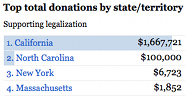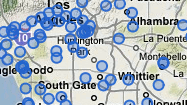Teacher responses to the 2010 release
The following is a list of teacher responses to their "value-added" ratings during the intial release in 2010. See the most recent responses »
The Times gave LAUSD elementary school teachers rated in this database the opportunity to preview their value-added evaluations and publicly respond. Some issues raised by teachers may be addressed in the FAQ. Teachers who have not commented may do so by contacting The Times.
|
|
 Delicious
Delicious
|
 Digg
Digg
|
 Facebook
Facebook
|
 Twitter
Twitter
|





It is a team effort, parent-teacher-child team, if any component is missing...it creates a weak link.
August 21, 2010 at 10:21 a.m.
How was this score determined? Does it take into account that many of the kids that we teach at this school are English Language Learners or that the standards change from grade to grade. Are the overall scores of the students taken into account, for example what they accomplished in 2nd and 3rd grades. The majority of our kids enter this grade with reading, writing, and mathematical levels that range from 1st to 3rd. However, the CST assesses the students on grade level standards. Many students make great gains and yet they might still be below grade level. Standardize testing is wasteful and not an appropreate tool to judge the competence of a teacher. The achievement of a student on the CST can be attributed to many factors such as physical, mental, and social. If a child comes to school tire on CST day, hi/her concentratin might suffer, the same might occur if the child did not get a goodnight sleep or if there was some problems in the yard before school. We try to elliminate as many barriers, but we cannot control what happens beyong our walls.
August 21, 2010 at 10:20 a.m.
It's not accurate to judge a teacher's performance without taking into account all the contributing student variables: attendance, eld level, economic background, homework, and classroom behavior - things which the CST does not measure.
August 21, 2010 at 10:15 a.m.
I teach at a math/science gifted/high achievement magnet where the students are expected to score well. When we had the norm reference test CAT6 we could see the true extent of our students and get a better idea of where to improve our instructions. On a criteria reference test CST it is difficult because our students will always score well because there is no way of showing the results of the enrichment and the push beyond grade level. When 88% of my 48 students (I team teach with another teacher, I teach the math and science) score advanced in math, I am still shown as an average teacher. I have an NBC, Bilingual/Bicultural competency certificate (a forerunner of the bilingual credential), and am the lead support provider in LD8 for the BTSA program. But according to your results I am an average teacher.
August 21, 2010 at 8:39 a.m.
I have been a teacher at Towne Ave. since 2001. Since then I have been encouraged to attend PDs for my personal & professional growth updating myself of current teaching tools & strategies to help my students succeed. In the course of time, I picked up ideas, experimented with them, adopted & implemented those I found were effective instructional strategies. A few of them are: standards based instructions, strong classroom mangement, HIGH EXPECTATIONS, differentiated instructions in a diversed classroom, DIBELS, RTII, & others. I use RUBRICS to guide students: rubrics for effort & achievement, rubrics for group discussion, rubrics for writing. Students learned to lead PT conferences,too.
August 21, 2010 at 8:02 a.m.
1. Teachers are told to use multiple measures to assess students, never to use only CST scores. So shouldn’t this be the same for teachers?
2. Blooms Taxonomy http://www.teachers.ash.org.au/researchskills/dalton.htm is more important to critical thinking than test prep.
3. Composition of classes varies from year to year.
4. Fallacy of using one average #, ups and downs of students within any class, and year to year.
5. Methodology is controversial among experts.
6. Teachers told the scores were confidential and would never be used in evaluation.
7. This is the death of all arts in school—now only test prep.
8. Beware of what you wish for—this data release is Pandora’s box—a nightmare for principals, teachers, and a feast for attorneys.
9. The period covered by this study coincides with the lengthy terminal illnesses of my parents in another city.
10. Glad I retired.
August 20, 2010 at 11:54 p.m.
At the very least, this series by the Times has fast-tracked the public discussion on teacher quality in the LAUSD. That is, I'm afraid, about the only good it has served. This allotted space is not nearly enough to address the many troubling issues with the publishing of these findings, so I will address a few. In your Teacher FAQ, the Times states "Another frequent criticism is that the complexity of the underlying statistical models make the approach difficult to explain to a lay audience, a fact than [sic] engenders some suspicion." Some suspicion is a gross understatement. In essence, the reader must blindly accept the ranking of their child's teacher and surrender hope of comprehension. This excuse is beyond weak, insults the public's intelligence, and why can't the company that created the program hire some technical writers to make the material comprehensible? It's what teachers must do everyday! The "lay person" will look at these results and deduce that one teacher is better than another. Can you imagine the maelstrom at the beginning of every school year when a parent receives their child's class assignment, checks the teacher's name on the database, and goes running to the front office demanding a change? This can not be the only measure of a teacher's worth, but that is what it will become. Another quote from the Teacher FAQ claims "Until now, parents have had no objective information about the effectiveness of their child’s teacher." This is what parent-teacher conferences are for. Talking to their child's teacher, face-to-face, should give a parent a very good indication of their professionalism. Checking their child's work and looking at the quality of their child's work over the course of a semester should tell them plenty about the effectiveness of the teacher. Parents have to be held accountable as much as teachers, administrators, District personnel, and the Superintendent. Finally, I am offended with the complete disregard regarding personal privacy. The data should be used at the school site as a jumping off point for the Principal to evaluate a teacher. Some very good teachers are going to be wrongly categorized due to the publishing of this data. If it was such a comprehensive model, States that have incorporated it would use it for more than the typical 10-30% of a teacher's evaluation. Are we going to apply the same statistical model to doctors, judges, attorneys, and every other profession?
August 20, 2010 at 11:41 p.m.
I fear that the emphasis on test scores will encourage more teaching to the test instead of the much more important skills such as critical thinking in both Math and Language Arts.
It will encourage a quantity over quality approach to teaching that adds no value whatsoever to student achievement.
This data would have been put to better use if it were not made public. It demeans our profession and the teachers who try their utmost to do a difficult job.What scores don't tell is the complete story of what goes into making an effective teacher, and it is so much more than a score on a test.
August 20, 2010 at 10:38 p.m.
Although the value-added measure might be a helpful tool for teachers to use in evaluating their teaching practices, it certainly does not paint the whole picture. Students who have little to no support at home, whose parents do not speak English, and who are worried about having their most basic needs met are surely not going to learn as readily as they might, no matter how effective the teacher may be. Standardized tests should not be used as the sole tool in evaluating teacher performance, just as they should not be used as the sole tool in evaluating student performance.
August 20, 2010 at 9:02 p.m.
"Value-added models provide important information, but that information is error-prone
and has a number of other important limitations. Moreover,
these methods are still under development, and the various
approaches now in use do not always paint the same picture.
Value-added estimates can be an important part of an evaluation
of teachers and schools, but they are not sufficient by themselves
for this purpose.” –David Koretz
August 20, 2010 at 7:18 p.m.